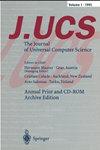Semi-Supervised Semantic Segmentation for Identification of Irrelevant Objects in a Waste Recycling Plant
IF 0.7
4区 计算机科学
Q4 COMPUTER SCIENCE, SOFTWARE ENGINEERING
引用次数: 0
Abstract
In waste recycling plants, measuring the waste volume and weight at the beginning of the treatment process is key for a better management of resources. This task can be conducted by using orthophoto images, but it is necessary to remove from those images the objects, such as containers or trucks, that are not involved in the measurement process. This work proposes the application of deep learning for the semantic segmentation of those irrelevant objects. Several deep architectures are trained and compared, while three semi-supervised learning methods (PseudoLabeling, Distillation and Model Distillation) are proposed to take advantage of non-annotated images. In these experiments, the U-net++ architecture with an EfficientNetB3 backbone, trained with the set of labelled images, achieves the best overall multi Dice score of 91.23%. The application of semi-supervised learning methods further boosts the segmentation accuracy in a range between 1.31% and 2.59%, on average.基于半监督语义分割的垃圾回收厂无关目标识别
在废物回收厂,在处理过程开始时测量废物体积和重量是更好地管理资源的关键。这项任务可以通过使用正射影像来完成,但有必要从这些图像中去除不涉及测量过程的物体,如集装箱或卡车。这项工作提出了将深度学习应用于这些不相关对象的语义分割。对几种深度架构进行了训练和比较,同时提出了三种半监督学习方法(伪标记、蒸馏和模型蒸馏)来利用未注释的图像。在这些实验中,采用高效率netb3主干的unet++架构,在标记图像集的训练下,获得了91.23%的最佳整体多Dice分数。半监督学习方法的应用进一步提高了分割准确率,平均在1.31% ~ 2.59%之间。
本文章由计算机程序翻译,如有差异,请以英文原文为准。
求助全文
约1分钟内获得全文
求助全文
来源期刊

Journal of Universal Computer Science
工程技术-计算机:理论方法
CiteScore
2.70
自引率
0.00%
发文量
58
审稿时长
4-8 weeks
期刊介绍:
J.UCS - The Journal of Universal Computer Science - is a high-quality electronic publication that deals with all aspects of computer science. J.UCS has been appearing monthly since 1995 and is thus one of the oldest electronic journals with uninterrupted publication since its foundation.
 求助内容:
求助内容: 应助结果提醒方式:
应助结果提醒方式:


